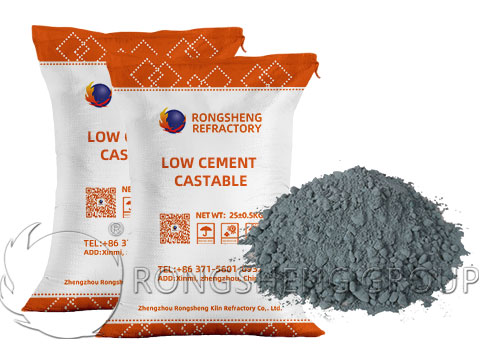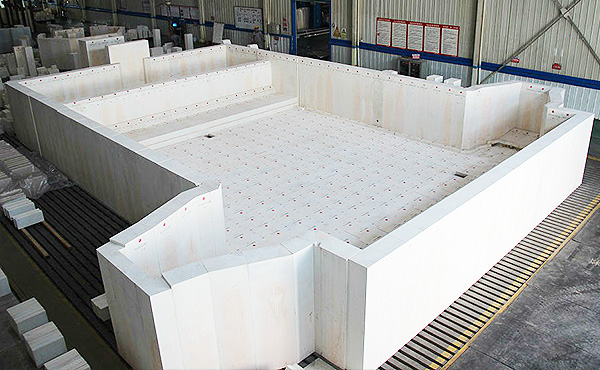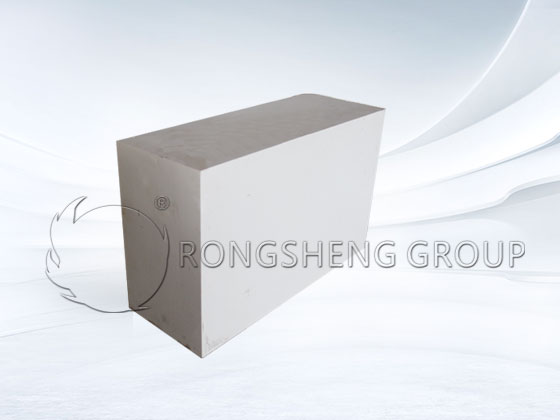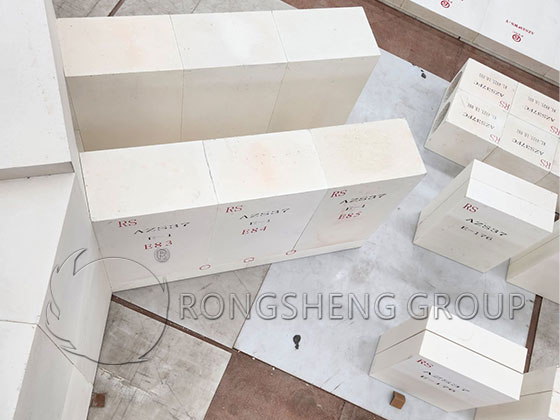Suitable for Aluminum Alloy Smelting – Unshaped Refractories Medium Temperature Low Cement Castable
The aluminum alloy melting process poses unique and demanding challenges to refractory materials, stemming from the physical and chemical properties of molten aluminum and its alloys. While the combustion chamber of an aluminum melting furnace can reach temperatures of approximately 1200°C, the furnace chamber area in direct contact with the molten aluminum typically only reaches temperatures of 700-800°C (the casting temperature for 6063 aluminum alloy is 720-740°C).
This means that the furnace lining material spends most of its time in a medium-temperature range, rather than a traditionally high-temperature state. In this temperature range, traditional refractories often experience a strength dip due to bonding phase transitions. For example, hydration products (such as CAH₁₀ and C₂AH₈) in cement-bonded Unshaped Refractories Castables begin to dehydrate at 300-400°C, losing their bonding properties while the ceramic bond is not yet fully formed, resulting in a significant drop in strength.

Low-Cement Castables: Medium- and Low-Temperature Strength Properties
Low-cement castables exhibit unique strength properties in the medium- and low-temperature ranges, distinct from conventional castables. During heating, conventional aluminate cement unshaped refractories castables typically experience a decrease in strength (due to hydrate dehydration) followed by an increase (due to ceramic bonding), with a distinct strength dip occurring in the 800-1000°C range. Low-cement refractory castables, however, exhibit a significant increase in strength at medium temperatures, rather than a decrease in strength.
The research examples in the table below demonstrate that the hot flexural strength of low-cement castables at 800°C is significantly higher than that at room temperature. Low-cement castables made primarily of kyanite-mullite (M45 and M60) exhibit the greatest increase in hot flexural strength with increasing treatment temperature. Low-cement castables made primarily of high-alumina bauxite (M85) exhibit the second-highest increase. Conventional Unshaped Refractories castables using CA-50 cement as a binder exhibit a distinct strength dip after firing at 800°C.
Table: Changes in hot flexural strength after treatment at different temperatures (MPa)
| Castable Sample Type | Dry at 110℃ | After Sintering at 800℃ | After Sintering at 1000℃ | After Sintering at 1200℃ | Strength Growth Characteristics |
| M45 | 8.5 | 10.2 | 12.8 | 15.3 | Sustained and stable growth |
| M60 | 9.2 | 11.5 | 14.2 | 17.6 | Significant increase in medium temperature strength |
| M85 | 10.7 | 12.3 | 14.9 | 18.2 | High initial strength and stable growth |
| Traditional CA-50 | 11.2 | 8.5 | 10.3 | 13.7 | The medium temperature strength decreased significantly |
The mechanism of this anomaly is that the dehydration of calcium aluminate hydrate in low-cement castables is slow and continuous, with minimal damage to the crystal structure. Simultaneously, the ultrafine powder begins to sinter at moderate temperatures, forming a preliminary ceramic bond.
Core Characteristics and Advantages of Low-Cement Castables
Low-Cement Castables (LCC) are a new generation of unshaped refractory materials developed in the 1980s. Compared to traditional aluminate cement Unshaped Refractories castables, their core characteristic lies in a significant reduction in the amount of calcium cement (typically from 12-20% to 3-8%). Furthermore, through the introduction of ultrafine powder technology and high-efficiency admixtures, they achieve a comprehensive performance optimization of high density, low porosity, and high strength.
The revolutionary breakthrough in low-cement castables stems from the application of ultrafine powder technology. Ultrafine powders (such as reactive SiO₂ powder and α-Al₂O₃ powder) with particle sizes less than 1.0μm can exceed 71%. These ultrafine particles possess an extremely high specific surface area and reactivity, effectively filling the gaps between aggregate particles and achieving the densest packing. It prevents particle size segregation, reduces porosity and pore diameter, ensures the fluidity of the mixture, and improves the density and bonding strength of the Unshaped Refractories castable. More importantly, the high specific surface area and reactivity of ultrafine powder significantly reduce sintering temperatures and promote sintering at medium and low temperatures.
Active SiO₂ ultrafine powder not only improves the fluidity of the castable but is also one of the most effective sintering accelerators. At temperatures above 900°C, SiO₂ ultrafine powder reacts with Al₂O₃ to form mullite (3Al₂O₃·2SiO₂), accompanied by a volume expansion of approximately 10.5%. This volume effect effectively offsets some of the volume shrinkage of the unshaped refractory castable, promoting strength improvement. Furthermore, the mullite phase forms at a relatively low temperature (beginning to form in large quantities at approximately 1000°C), and its needle-shaped or columnar crystal structure forms a cross-linked skeleton, significantly enhancing the material’s strength.
Ultrafine α-Al₂O₃ powder strengthens the material through a different mechanism. It promotes the formation of calcium hexaaluminate (CA₆) from calcium aluminate at high temperatures, along with smaller amounts of mullite, anorthite, CA, and CA₂. These minerals have large molar volumes, which prevent volume shrinkage. Furthermore, CA₆ crystals are small columnar and needle-shaped, while anorthite crystals are fine columnar. Together, they form a cross-linked structure of fine columnar and needle-shaped structures, resulting in a strong and dense structure that can reach strengths of around 100 MPa.
The setting and hardening mechanism of low-cement castables is also fundamentally different from that of traditional Unshaped Refractories castables. Traditional castables primarily derive their strength from hydration products (such as CAH₁₀ and C₂AH₈) produced by cement hydration. However, these hydrates dehydrate and decompose during heating, significantly reducing their strength at medium temperatures. Low-cement castables, on the other hand, rely primarily on a cohesive bonding mechanism: ultrafine powder particles form colloidal particles in water, which form a three-dimensional network structure through van der Waals forces and chemical bonds, tightly binding the aggregate particles together. Cement acts only as a delayed-acting setting accelerator. This cohesive mechanism ensures that the strength of low-cement castables does not decrease due to hydrate decomposition during heating, but instead continues to increase due to sintering.
By carefully controlling the type, particle size distribution, and additive amount of fine powder, low-cement castables achieve an ideal strength development curve within the operating temperature range of aluminum alloy smelting (700-900°C). This avoids the mid-temperature strength trough common in traditional Unshaped Refractories castables while providing sufficient high-temperature performance, perfectly adapting to the unique operating conditions of aluminum melting furnaces.
However, there are downsides. Low porosity and high densification also result in poor air permeability. During baking and heating, steam generated by internal moisture cannot be promptly dissipated, easily building up high pressure within the lining, causing it to spall or crack. Therefore, when using low-cement castables, a reasonable baking system and the addition of explosion-proof agents must be used.
Conclusion
From the “medium-temperature dilemma” of traditional Unshaped Refractories castables to the “precise breakthrough” of low-cement castables, the path to upgrading refractory materials is essentially a matter of precisely matching material properties with operating requirements. For the unique application of aluminum alloy smelting, low-cement castables restructure their strength formation mechanism through ultrafine powder technology. This not only addresses the strength limitations of the medium-temperature range, but also addresses the core requirements of high density and corrosion resistance. This makes them a key material support for the longevity and high efficiency of aluminum industry furnaces.


